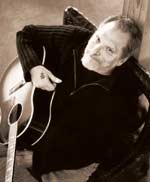Hesitation Blues
For as long as this tune has been around—since at least the beginning of the 20th century—folks have been having a grand old time making up new and ever more outrageous verses for it. Apparently that's how Art Gilham, Billy Smythe and Scott Middleton came up with the first published version: by making up new verses to a traditional tune, just to pass the time. A well-known vaudeville and mintrel performer by the name of Al Bernard recorded it for Edison Records with full orchestration in 1919. Here's a clip, (with thanks to U.C. Santa Barbara's amazing Cylinder Preservation and Digitization Project).
Audio Clip: Al Bernard performing Hesitation Blues for Edison Records in 1919.
 |
If that's a little high falutin' for your tastes, try a little Charlie Poole and the North Carolina Ramblers. They recorded the song under the title, If The River Was Whiskey. Mind you, this may sound like back woods music to us now, but for string band music in the 1920's this was very sophisticated stuff. Poole and the Ramblers made a point, in fact, of eschewing some of the aw' shucks antics of their contemporaries, opting instead for a polished presentation, including nice duds as you can see from the photo to the left. That's Poole on the banjo, using a fingerpicking (as opposed to clawhammer) style he pioneered and which is said to have been both novel and influential.
Audio Clip: Charlie Poole and the North Carolina Ramblers
 |
When the Holy Modal Rounders covered this song on their 1964 debut, that was the version they were leaning on. But around that same time other versions were in circulation among folkies as well, including that of Rev. Gary Davis (shown right). Davis has been a hugely influential fingerstyle guitarist in blues and ragtime circles. Though you'd never know it from the risqué verses of his Hesitation Blues, he was an ordained minister who built both his preaching and playing skills on street corners from Durham SC to Harlem. Much of his repertoire was gospel music, but whether the vehicle was sacred or profane, his guitar playing was rich with the counterpoint and synchopation that continues to make it a revelation (and challenge!) to this day.
The audio clip below is from a live recording of Rev. Gary Davis at a small club. Notice that his chord progression is much more like that of our arrangement, including the Am – E7 section that (you may have noticed) is not part of the versions we heard above. The full song runs over 11 minutes on this recording, with Davis spinning verse upon verse, many of which are based on this structure:
I ain't no fireman, no fireman's son
But I can keep you warm 'til the fireman comes
Substitute just about anything for "fireman", figure out what you're going to do 'til that person comes and voilá, you've got yourself a new verse. The trick is coming up with 11 minute's worth of instrumental breaks as well, as does Davis! Here he is in action:
Audio Clip: Rev. Gary Davis performing Hesitation Blues
 |
Rev. Gary Davis' version of Hesitation Blues has been the inspiration and template for many other contemporary arrangements, including one of the best-known, that of Hot Tuna's Jorma Kaukonen. Once upon a time, Kaukonen was the lead guitarist for the psychedelic rock group Jefferson Airplane, but his first love had always been acoustic roots music and that's what he's best known for these days. Even at the height of the Airplane's popularity, he and the band's bassist Jack Casady would perform as an acoustic duo that became known as Hot Tuna, and Hesitation Blues has been a favorite from the earliest days. This clip is from a live radio show they did in 1971on KSAN-FM that has been released on Relix Records.
Audio Clip: Hot Tuna performs Hesitation Blues
Recommended Recordings
All Community Guitar Resources text & material © 2006 Andrew Lawrence
